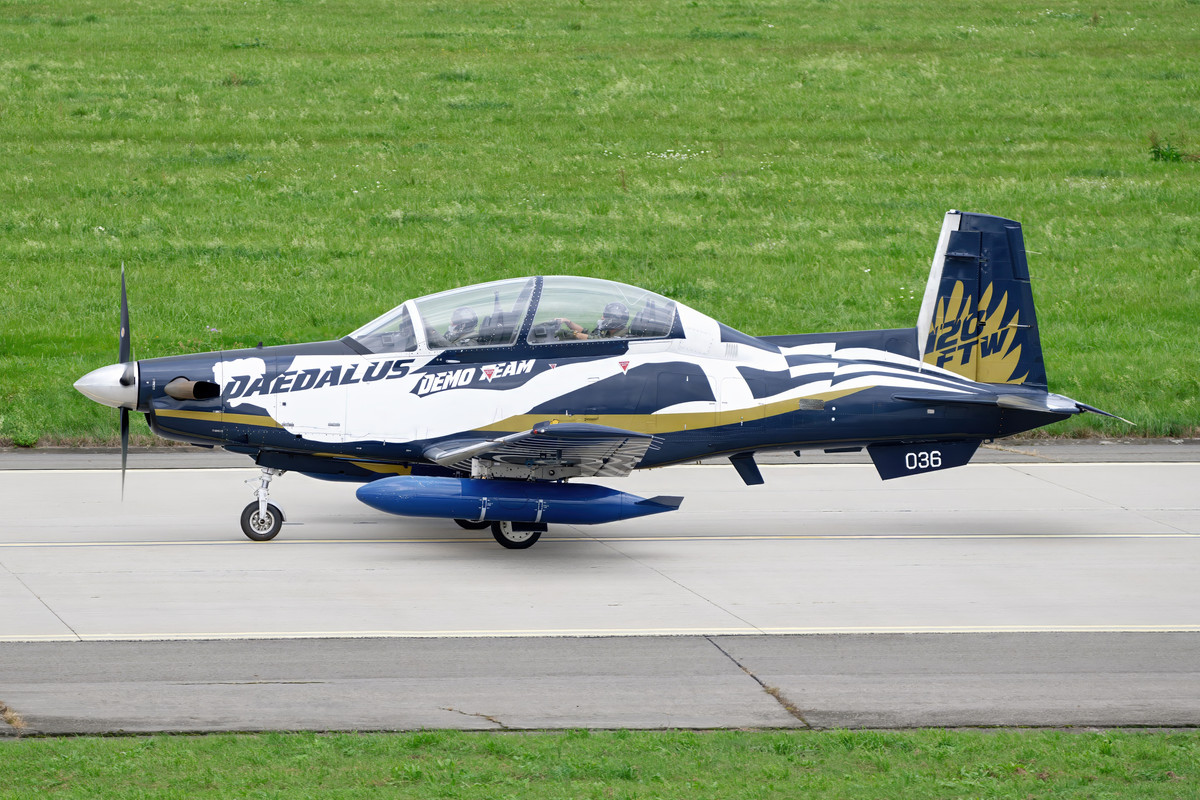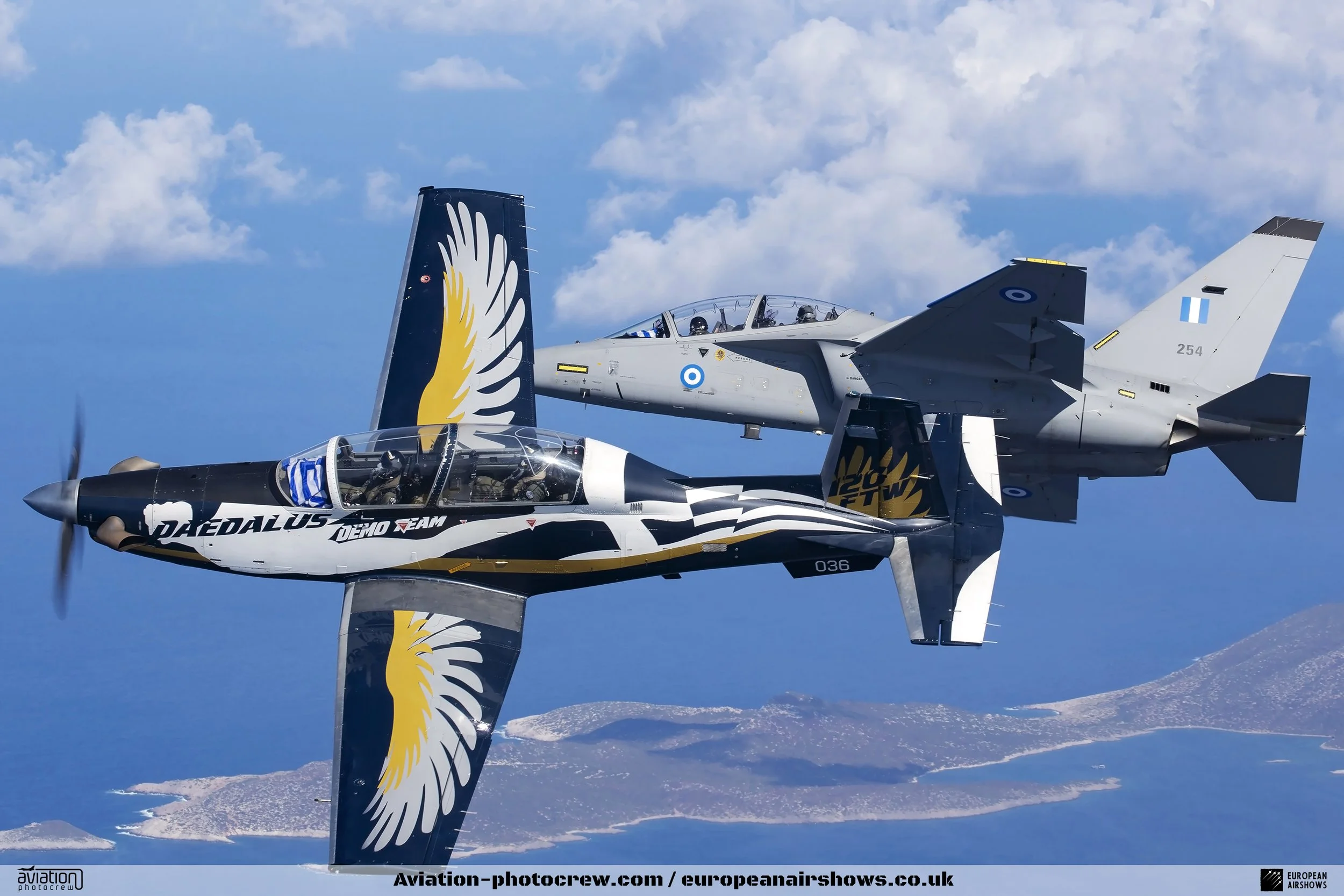
Daedalus Demo Team
T-6A Aircraft Demonstration Team
The Daedalus Demo Team, officially known as the T-6A Aircraft Demonstration Team, is a solo demonstration unit within the Hellenic Air Force, established in 2005 during the 1st International Air Show “Archangel.” This team operates the T-6A Texan II training aircraft, a choice that reflects its dual role in both performance and pilot training. The team's primary objectives are to spread and cultivate the air concept within the Greek community, enhance the morale of the Hellenic Armed Forces, and project the work of the Air Force cadres to the wider public. These goals underscore the team's role not only as entertainers but also as ambassadors for aviation and military pride.
The establishment of the Daedalus Demo Team in 2005 marked a significant revival for the Hellenic Air Force's acrobatic flight history, which had seen a hiatus of approximately four decades following earlier teams like the "Four Aces," "Acro Team," "Greek Flame," and "New Greek Flame." The team's formation during the “Archangel” air show, specifically on 18 September 2005 at 114 Combat Wing, Tanagra, was a public debut that highlighted its importance. This event, held in honor of the HAF Patrons Archangels Michael and Gabriel, set the stage for the team's ongoing presence at airshows, where it continues to captivate audiences with its aerial displays.
The team's composition is meticulously structured to ensure both safety and spectacle. It includes a main demonstration pilot, responsible for executing the aerial maneuvers, a flight and ground safety observing officer who monitors the flight project's safe conduct and can intervene if necessary, a narrator officer who provides commentary during performances, and aircraft preparation and support technical personnel who ensure the T-6A Texan II is ready for each show. Training for the team began on 26 July 2005 and concluded on 16 August 2005, involving 18 co-pilot flights, 12 solo flights, and a total of 20.8 hours. This training was conducted by USAF instructors Captain Jeff Stift and Captain Eric Mc Umper at 120 Air Training Wing, Kalamata, with five pilots from 361 Air Training Squadron trained, and Major (I) Nikolaos Chriistopoulos and Major (P) Nikolaos Malapanis selected for air show performances.
Performance-wise, the Daedalus Demo Team offers two distinct show types to accommodate varying weather conditions. The High Show requires a minimum cloud base of 4500 ft Above Ground Level (AGL) and 5 km visibility, while the Flat Show operates with a lower cloud base of 2500 ft AGL but maintains the same visibility requirement. Both shows feature an impressive array of maneuvers including the Takeoff Roll, Cuban Eight, Eight Point Roll, Reverse Half Cuban Eight, Texas Sidewinder, Level 360°- Kerry Turn, Fish Hook, Opposing Roll – High Speed, Landing Gear down Pass, Rapid rise for photography, High Speed Photo Pass, and a Tactical Pitch-up to Land. These maneuvers showcase the team's technical prowess and the aircraft's versatility, providing a visual spectacle that combines artistry with precision.
About the T-6 Texan II
The Beechcraft T-6 Texan II is a single-engine turboprop trainer aircraft developed by Beechcraft, now a division of Textron Aviation. It was designed to meet the requirements of the Joint Primary Aircraft Training System (JPATS) program, which aimed to replace the aging T-37 Tweet and T-34C Turbo Mentor trainers used by the United States Air Force and United States Navy, respectively. Based on the Pilatus PC-9, a Swiss-designed trainer, the T-6 Texan II incorporates significant modifications, including a strengthened airframe, advanced avionics, and Martin-Baker ejection seats. The aircraft made its first flight on July 15, 1998, and entered service with the U.S. Air Force in May 2000, quickly becoming the primary trainer for both the Air Force and the Navy.
The T-6 Texan II is powered by a Pratt & Whitney Canada PT6A-68 turboprop engine, delivering 1,100 shaft horsepower, and features a glass cockpit with digital displays that simulate the systems found in modern military aircraft. It is fully aerobatic, capable of performing a wide range of maneuvers essential for pilot training, and includes safety features such as ejection seats and a bird-resistant canopy. With a maximum speed of approximately 320 mph and a service ceiling of 31,000 feet, the T-6 provides a versatile platform for teaching basic and advanced flying skills.
In addition to its use by the United States military, the T-6 Texan II has been adopted by several other air forces worldwide, including the Royal Canadian Air Force (as the CT-156 Harvard II), the Hellenic Air Force, the Israeli Air Force, and the Iraqi Air Force. Variants of the aircraft include the T-6B, which features an upgraded avionics suite for naval training, and the AT-6 Wolverine, a light attack version equipped for combat missions. Over 850 units have been delivered to various operators, making the T-6 Texan II a cornerstone of military pilot training programs globally.
Specifications
Crew
Two
Length
33 ft 4 in (10.16 m)
Wingspan
33 ft 5 in (10.19 m)
Height
10 ft 8 in (3.25 m)
Max Speed
320 mph (510 km/h)
Range
1,000 mi (1,700 km)
Service Ceiling
31,000 ft (9,400 m)
Max Takeoff Weight
6,500 lb (2,948 kg)
T-6 Texan II in the Hellenic Air Force
The Hellenic Air Force (HAF) operates the T-6 Texan II as its primary trainer aircraft. In the early 2000s, the HAF acquired a fleet of T-6A and T-6A NTA (New Trainer Aircraft) variants, with the latter featuring underwing hardpoints for carrying external stores such as practice bombs or fuel tanks. Based at Kalamata Air Base, these aircraft are used for both basic and advanced pilot training, preparing Greek pilots for transition to more advanced aircraft such as the F-16 Fighting Falcon. The T-6 Texan II has been integral to the HAF's training program, offering a modern and efficient platform that enhances the skills of future combat pilots.
Did You Know?
- The T-6 Texan II is named after the WWII-era North American T-6 Texan but is a completely different aircraft with modern technology.
- It features a pressurized cockpit, allowing it to operate at altitudes up to 31,000 feet, which is higher than many other trainers.
- The aircraft is equipped with a glass cockpit, providing pilots with advanced avionics similar to those in frontline fighters.
- A variant called the AT-6 Wolverine is designed for light attack missions, equipped with weapons and sensors for combat roles.
- The T-6 Texan II has been adopted by multiple countries, including Greece, Canada, and Israel, demonstrating its international success.
Test Your Knowledge
1. What is the maximum speed of the T-6 Texan II?


